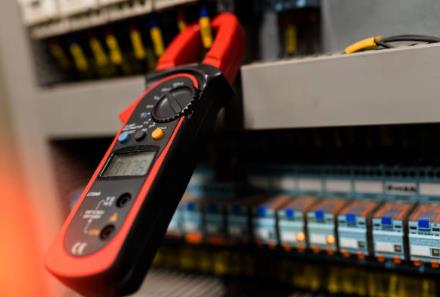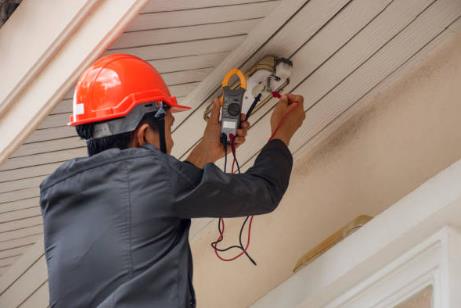A clamp meter is a handheld device to measure electrical current without having to touch and disconnect the circuit for easier and faster measurements. The“clamp” that is hinged, opens to encircle a conductor, which can be a wire or a cable, to measure the current that is passing through it.
Clamp meters use electromagnetic induction for measurement, making it non-contact unlike traditional multimeters. This offers greater safety and convenience to users than traditional multimeters.
A clamp meter works primarily based on Faraday's Law of Electromagnetic Induction. Each time an electric powered field passes through a conductor, an electromagnetic field is fashioned. Next, the clamp on the meter is built to identify the electromagnetic field. It identifies the field and changes it into an electrical pulse, which the meter shows is a reading of a current.
In order to ensure that a Clamp Meter provides accurate and secure readings, the four steps detailed below should be followed carefully. The steps detailed below incorporate both the setup and measurement processes in their entirety to promote clear understanding.
Most clamp meters let you pick between DC and AC. For example, electric meters are DC while car battery and solar panel circuits are AC.
digital clamp meter ac 400a
Step 3: Open and Position the Clamp Around a Single Conductor
Firmly grasp the clamp meter and open the jaws by pressing the lever. Place the open jaws around a single conductor (wire).
REMINDER: Do not insert the entire cable or bunch of wires into the clamp. Measure only one conductor. Failure to do so will result in incorrect, cancelled readings due to the offset magnet field.
This step will allow the meter to sense the magnet field made by the current that is flowing in and through the wire.
Step 4: Detection of Magnet Field and Signal Conversion
When the jaws are fully closed around the conductor, the Clamp Meter finds the magnet field that is created when the current is running through the wire.
There is a coil inside the clamp that will sense and capture the field.
The meter will then change the field into a magnet field, and then into an electrical field that will represent the current that is flowing in and through.
This is the basis of Faraday's Law of Electromagnetic Induction.
Fifth Step: Look on the Digital Display
When you operate the clamp meter and get a reading, it appears on the display in amps (A).
Wait a moment so it may stabilize earlier than taking your analysis.
If it repeatedly shows different readings, position the clamp differently, and ensure only one wire is inside the clamp.
This step shows the current measurement clearly and reliably, with no disruption to the electrical circuit.

Sixth Step: Safety Precautions for Reliable Readings
A clamp meter is a gadget; it must be used safely. To maximise the safety of a clamp meter, remember to:
Not clamp multiple wires. Measuring wires with opposing current will cancel out
Do not take measurements in the rain.
Always hold it from the insulated handle, so it won't give you a shock.
Don't open the clamp if it is on a high voltage live wire.
If the guidelines above are followed, the clamp meter will be safe and efficient for any electrical job.
Why Rely on a Clamp Meter:
One Clamp Meter guarantees electrical system testing with precision, safety, and best of all, practicality. Taking into consideration, estimating, and being in a position to ease and complete a task comfortably encompasses all the best qualities needed for an effective tool. Here are the advantages and all the explanations on why this tool proves itself.
1. Improved Measurement Safe
A clamp meter authorizes the user to perform the most-advanced electrical system testing. Measuring and recording current with a clamp meter, the user must remain a safe distance from the system being tested without disconnecting the system being tested.
The advantage here is the various user safety offered. This is the most effective user and system safety during electrical system testing at home and in bigger settings and industries.
2. Performing Tasks with No Boundaries
A clamp meter's electrical current measurements are taken effectively and without the user needing to disconnect the electrical system.
This is especially a warm welcome in busy areas of malls, electric markets, machine and vehicle repair locations, and during electrical system servicing, and testing. This instrument saves a clamp meter user time, and gives active session back, maintenance control, and testing control quickly.
3. Advanced Reading
The best and most modern clamp meters make testing more easy and convenient for professionals; advanced testing along the electrical system can provide and produce exact expected testing values, readings, and the system.
They can measure AC and DC currents securely and reliably, ensuring that every recording is done according to safety guidelines and performance regulations.
This precise measuring capability makes it possible for the clamp meter to be utilized in both diagnostic and preventive maintenance work.
Most clamp meters offer more features to users than just measuring the current.
They measure voltage, resistance, frequency and continuity which gives the user more testing functions in one small device.
Having less tools is beneficial because it saves the user effort. This is great for those in the field and solving problems on the go.
This design feature allows the meter to measure and work on live, low and high currents safely.
This helps in saving time.
Technicians can diagnose faults faster, which enhances overall workflow and productivity.
Applications of Clamp Meter
A clamp meter
Electrical Maintenance: Measuring cutting-edge in commercial circuits and in equipment.
Home Wiring: Examining appliances and testing the power supply lines.
Automotive: Current measurement in alternators and car batteries.
Solar Systems: Current monitoring in batteries and solar panels.
HVAC Systems: Fitting and Fault repair in the electrical circuitry of air conditioning units.
The above uses show how vital the clamp meter is to the professional and the enthusiast.
Clamp Meter vs. Multimeter: What's the Difference?
Although both gear degree electric parameters, their functions range.
| Feature | Clamp Meter | Multimeter |
| Current Measurement | High current, non-contact | Low current, direct contact |
| Safety Level | High | Moderate |
| Ease of Use | Simple and fast | Requires circuit disconnection |
| Accuracy for Current | Excellent | Limited |
| Portability | Handheld and lightweight | Handheld, but requires probes |
A multimeter can check little amounts of voltage but a Clamp Meter is far more safe, flexible, and efficient, which is why it is the most preferred tool for professional electrical testing.
Clamp Meter Care and Maintenance
For your clamp meter to be efficient for a long time, simple maintenance is required.
Cleaning and drying it is a must. Dust has to be avoided and it should not be dropped, so save it in a protective case.
Keep tune of battery changes and calibrations.
When not in use, it is great to keep away from robust magnetic fields.
Proper interest in these points ensures accuracy and reliability in the end.
Future of Clamp Meters in Electrical Testing
Clamp meters are becoming more advanced with new technological developments. The addition of Bluetooth integration, data logging, and smart displays help technicians record and analyze current readings on their phones. This convenience and portability, help technicians work more efficiently.
The future of clamp meters will include more automation for improved safety and precision in completing intricate electrical tasks.
Conclusion
The clamp meter is a measuring instrument, assuring the safety of workers and providing diagnostic capabilities. The contactless measuring of current, along with precision and convenience, gives the clamp meter its worth in today's civilization for electrical work meters are critical in ensuring electric structures in homes, industries, and even renewable strength sources are safe, powerful, and dependable. The operation, advantages, and packages of the tool assist clients use it efficiently and competently.





















Comments
No comment